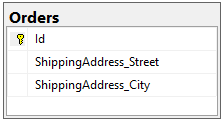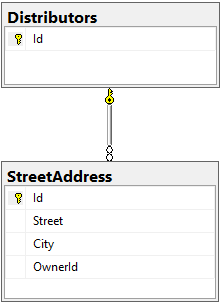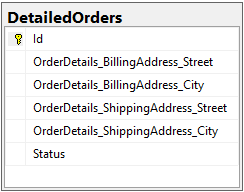Owned Entity Types
EF Core allows you to model entity types that can only ever appear on navigation properties of other entity types. These are called owned entity types. The entity containing an owned entity type is its owner.
Owned entities are essentially a part of the owner and cannot exist without it, they are conceptually similar to aggregates. This means that the owned entity is by definition on the dependent side of the relationship with the owner.
Configuring types as owned
In most providers, entity types are never configured as owned by convention - you must explicitly use the OwnsOne method in OnModelCreating or annotate the type with OwnedAttribute to configure the type as owned. The Azure Cosmos DB provider is an exception to this. Because Azure Cosmos DB is a document database, the provider configures all related entity types as owned by default.
In this example, StreetAddress is a type with no identity property. It is used as a property of the Order type to specify the shipping address for a particular order.
We can use the OwnedAttribute to treat it as an owned entity when referenced from another entity type:
[Owned]
public class StreetAddress
{
public string Street { get; set; }
public string City { get; set; }
}
public class Order
{
public int Id { get; set; }
public StreetAddress ShippingAddress { get; set; }
}
It is also possible to use the OwnsOne method in OnModelCreating to specify that the ShippingAddress property is an Owned Entity of the Order entity type and to configure additional facets if needed.
modelBuilder.Entity<Order>().OwnsOne(p => p.ShippingAddress);
If the ShippingAddress property is private in the Order type, you can use the string version of the OwnsOne method:
modelBuilder.Entity<Order>().OwnsOne(typeof(StreetAddress), "ShippingAddress");
The model above is mapped to the following database schema:

See the full sample project for more context.
Tip
The owned entity type can be marked as required, see Required one-to-one dependents for more information.
Implicit keys
Owned types configured with OwnsOne or discovered through a reference navigation always have a one-to-one relationship with the owner, therefore they don't need their own key values as the foreign key values are unique. In the previous example, the StreetAddress type does not need to define a key property.
In order to understand how EF Core tracks these objects, it is useful to know that a primary key is created as a shadow property for the owned type. The value of the key of an instance of the owned type will be the same as the value of the key of the owner instance.
Collections of owned types
To configure a collection of owned types use OwnsMany in OnModelCreating.
Owned types need a primary key. If there are no good candidates properties on the .NET type, EF Core can try to create one. However, when owned types are defined through a collection, it isn't enough to just create a shadow property to act as both the foreign key into the owner and the primary key of the owned instance, as we do for OwnsOne: there can be multiple owned type instances for each owner, and hence the key of the owner isn't enough to provide a unique identity for each owned instance.
The two most straightforward solutions to this are:
- Defining a surrogate primary key on a new property independent of the foreign key that points to the owner. The contained values would need to be unique across all owners (e.g. if Parent {1} has Child {1}, then Parent {2} cannot have Child {1}), so the value doesn't have any inherent meaning. Since the foreign key is not part of the primary key its values can be changed, so you could move a child from one parent to another one, however this usually goes against aggregate semantics.
- Using the foreign key and an additional property as a composite key. The additional property value now only needs to be unique for a given parent (so if Parent {1} has Child {1,1} then Parent {2} can still have Child {2,1}). By making the foreign key part of the primary key the relationship between the owner and the owned entity becomes immutable and reflects aggregate semantics better. This is what EF Core does by default.
In this example we'll use the Distributor class.
public class Distributor
{
public int Id { get; set; }
public ICollection<StreetAddress> ShippingCenters { get; set; }
}
By default the primary key used for the owned type referenced through the ShippingCenters navigation property will be ("DistributorId", "Id") where "DistributorId" is the FK and "Id" is a unique int value.
To configure a different primary key call HasKey.
modelBuilder.Entity<Distributor>().OwnsMany(
p => p.ShippingCenters, a =>
{
a.WithOwner().HasForeignKey("OwnerId");
a.Property<int>("Id");
a.HasKey("Id");
});
The model above is mapped to the following database schema:

Mapping owned types with table splitting
When using relational databases, by default reference owned types are mapped to the same table as the owner. This requires splitting the table in two: some columns will be used to store the data of the owner, and some columns will be used to store data of the owned entity. This is a common feature known as table splitting.
By default, EF Core will name the database columns for the properties of the owned entity type following the pattern Navigation_OwnedEntityProperty. Therefore the StreetAddress properties will appear in the 'Orders' table with the names 'ShippingAddress_Street' and 'ShippingAddress_City'.
You can use the HasColumnName method to rename those columns.
modelBuilder.Entity<Order>().OwnsOne(
o => o.ShippingAddress,
sa =>
{
sa.Property(p => p.Street).HasColumnName("ShipsToStreet");
sa.Property(p => p.City).HasColumnName("ShipsToCity");
});
Note
Most of the normal entity type configuration methods like Ignore can be called in the same way.
Sharing the same .NET type among multiple owned types
An owned entity type can be of the same .NET type as another owned entity type, therefore the .NET type may not be enough to identify an owned type.
In those cases, the property pointing from the owner to the owned entity becomes the defining navigation of the owned entity type. From the perspective of EF Core, the defining navigation is part of the type's identity alongside the .NET type.
For example, in the following class ShippingAddress and BillingAddress are both of the same .NET type, StreetAddress.
public class OrderDetails
{
public DetailedOrder Order { get; set; }
public StreetAddress BillingAddress { get; set; }
public StreetAddress ShippingAddress { get; set; }
}
In order to understand how EF Core will distinguish tracked instances of these objects, it may be useful to think that the defining navigation has become part of the key of the instance alongside the value of the key of the owner and the .NET type of the owned type.
Nested owned types
In this example OrderDetails owns BillingAddress and ShippingAddress, which are both StreetAddress types. Then OrderDetails is owned by the DetailedOrder type.
public class DetailedOrder
{
public int Id { get; set; }
public OrderDetails OrderDetails { get; set; }
public OrderStatus Status { get; set; }
}
public enum OrderStatus
{
Pending,
Shipped
}
Each navigation to an owned type defines a separate entity type with completely independent configuration.
In addition to nested owned types, an owned type can reference a regular entity which can be either the owner or a different entity as long as the owned entity is on the dependent side. This capability sets owned entity types apart from complex types in EF6.
public class OrderDetails
{
public DetailedOrder Order { get; set; }
public StreetAddress BillingAddress { get; set; }
public StreetAddress ShippingAddress { get; set; }
}
Configuring owned types
It is possible to chain the OwnsOne method in a fluent call to configure this model:
modelBuilder.Entity<DetailedOrder>().OwnsOne(
p => p.OrderDetails, od =>
{
od.WithOwner(d => d.Order);
od.Navigation(d => d.Order).UsePropertyAccessMode(PropertyAccessMode.Property);
od.OwnsOne(c => c.BillingAddress);
od.OwnsOne(c => c.ShippingAddress);
});
Notice the WithOwner call used to define the navigation property pointing back at the owner. To define a navigation to the owner entity type that's not part of the ownership relationship WithOwner() should be called without any arguments.
It is also possible to achieve this result using OwnedAttribute on both OrderDetails and StreetAddress.
In addition, notice the Navigation call. Navigation properties to owned types can be further configured as for non-owned navigation properties.
The model above is mapped to the following database schema:

Storing owned types in separate tables
Also unlike EF6 complex types, owned types can be stored in a separate table from the owner. In order to override the convention that maps an owned type to the same table as the owner, you can simply call ToTable and provide a different table name. The following example will map OrderDetails and its two addresses to a separate table from DetailedOrder:
modelBuilder.Entity<DetailedOrder>().OwnsOne(p => p.OrderDetails, od => { od.ToTable("OrderDetails"); });
It is also possible to use the TableAttribute to accomplish this, but note that this would fail if there are multiple navigations to the owned type since in that case multiple entity types would be mapped to the same table.
Querying owned types
When querying the owner the owned types will be included by default. It is not necessary to use the Include method, even if the owned types are stored in a separate table. Based on the model described before, the following query will get Order, OrderDetails and the two owned StreetAddresses from the database:
var order = await context.DetailedOrders.FirstAsync(o => o.Status == OrderStatus.Pending);
Console.WriteLine($"First pending order will ship to: {order.OrderDetails.ShippingAddress.City}");
Limitations
Some of these limitations are fundamental to how owned entity types work, but some others are restrictions that we may be able to remove in future releases:
By-design restrictions
- You cannot create a
DbSet<T>for an owned type. - You cannot call
Entity<T>()with an owned type onModelBuilder. - Instances of owned entity types cannot be shared by multiple owners (this is a well-known scenario for value objects that cannot be implemented using owned entity types).
Current shortcomings
- Owned entity types cannot have inheritance hierarchies
Shortcomings in previous versions
- In EF Core 2.x reference navigations to owned entity types cannot be null unless they are explicitly mapped to a separate table from the owner.
- In EF Core 3.x the columns for owned entity types mapped to the same table as the owner are always marked as nullable.
